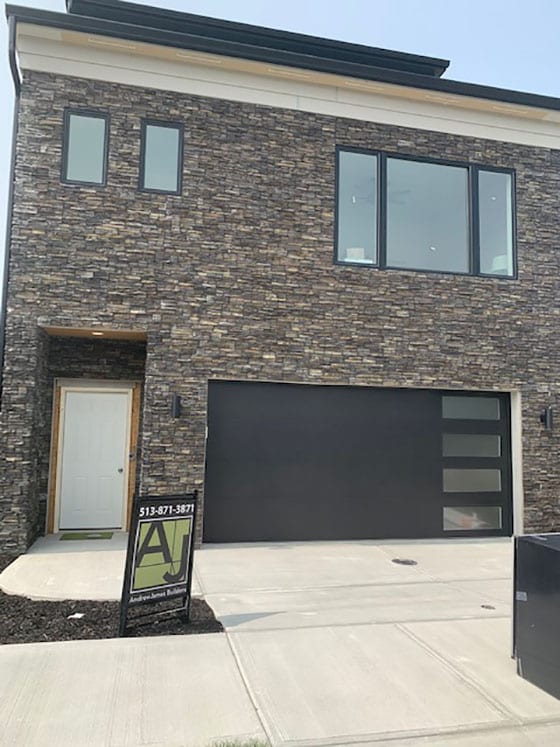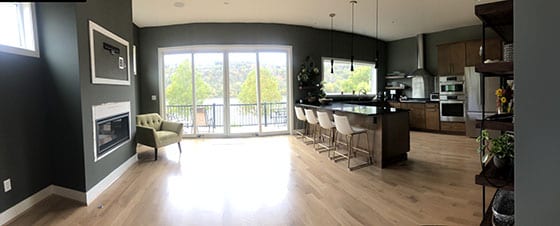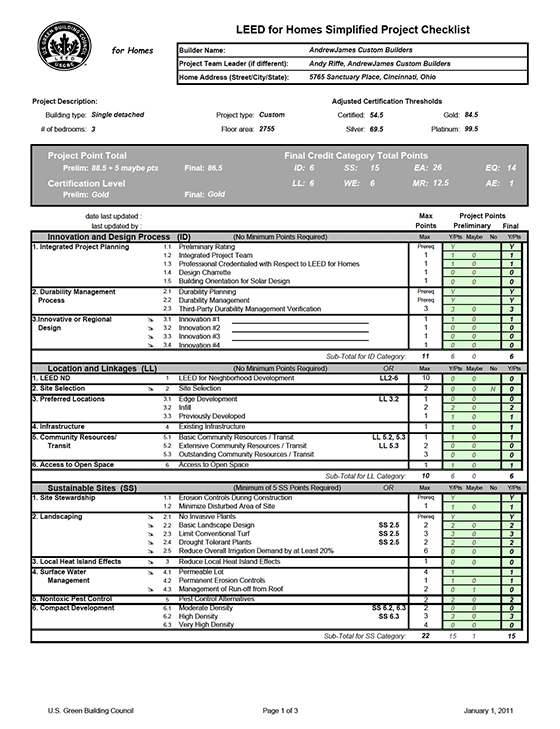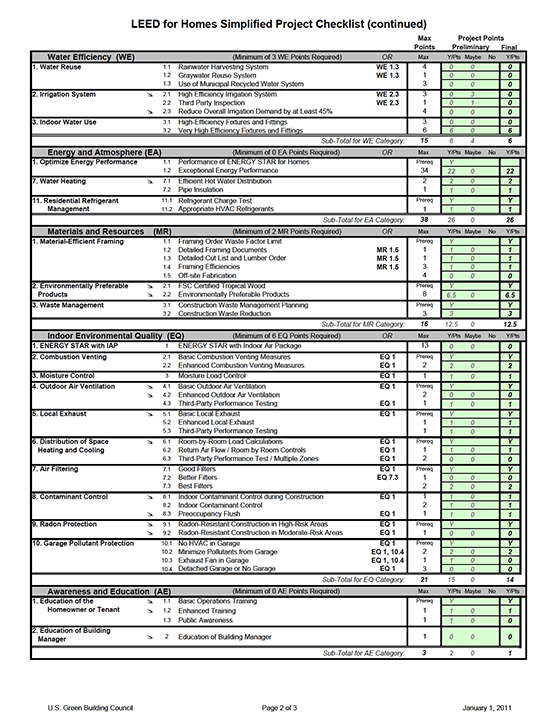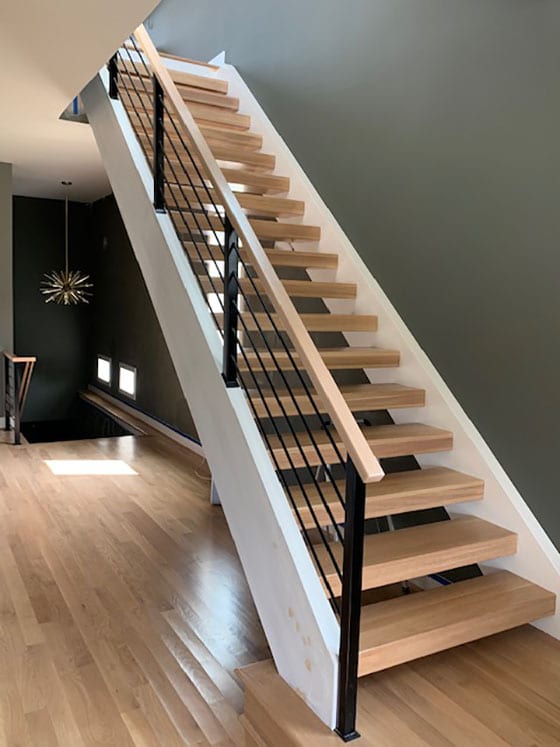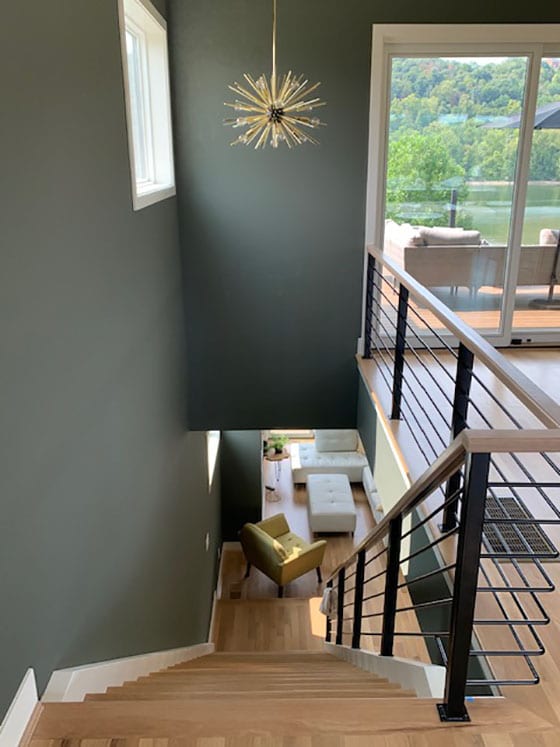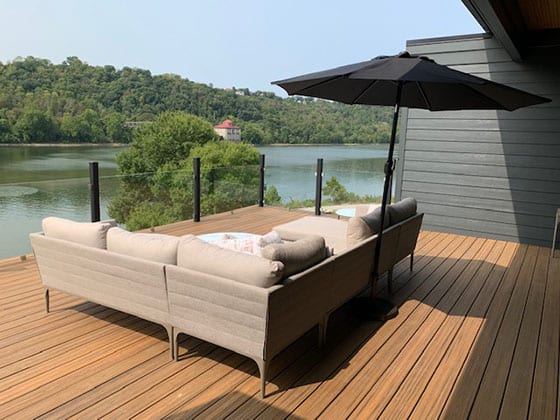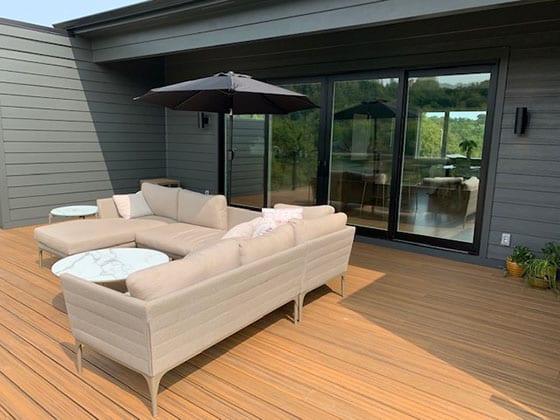This is Andrew James Builders’, a Hyde Park Business, 25th LEED Home. LEED Home certification by USGBC is for achievements in green home building and design.
LEED for Homes is a third-party certification system for building and designing high-performance green homes that are energy-and-resource-efficient and healthy for its occupants. LEED certified homes are completed to a technically rigorous process that often include a home energy (HERS) rating and onsite inspections to verify that the home is built to be energy and water efficient, environmentally sound, and a healthier place to live.
Andrew Riffe of Andrew James Builders said, “We are proud to achieve this number of LEED Homes and are committed to build LEED energy efficient and sustainable homes.” LEED Homes qualify for the City of Cincinnati tax abatement. Providing energy efficient homes with no taxes on the structure for 15 years is a very powerful incentive, and helping keep homeownership affordable,” adds Riffe.
As a LEED-certified home builder Andrew James Builders serves as a model of greener living for the entire community,” said Nate Kredich, Vice President of Residential Market Development for the USGBC. “The home sets the example that we can all live better by reducing our environmental footprint, cutting our utility bills, and coming home to a greener place to live.”
Cincinnati history of tax abatements
Since 2002, the city of Cincinnati has granted 10-year tax abatement on structures. In 2007, the city added an additional five years to the tax abatement for those receiving LEED Certification. In 2011, the tax abatement for LEED became a bit more layered and difficult. Now, owners must achieve LEED Silver to receive a tax break on the first $285,000 of the structure’s value. LEED Gold has a limit of $565,000, and it’s unlimited if you achieve LEED Platinum. Because of the tax abatement, nearly every new home in Cincinnati is LEED Certified and builders have become quite familiar with how to do it cost effectively.
Certification level decision story – LEED for Homes
The LEED for Homes Rating System provides a basis for quantifying the benefits of green homes, thereby facilitating the widespread construction of more sustainable homes. One of the first steps in planning a LEED home is to adjust the certification thresholds based on the material and energy impacts. All else being equal, a large home consumes more materials and energy than a small home over its lifecycle. LEED compensates for these impacts by adjusting the thresholds for each award level. Thresholds for smaller-than-average homes are lowered, and thresholds for larger-than-average homes are raised. A home’s threshold for LEED Gold may be 72 points. A 4,500-sq.-ft. home with five bedrooms would be about 85 points.
In the end, the homeowner will have a well built and third-party certified home. Passing the blower door test alone is significant. Blower door tests are used to prove the air sealing quality of the construction. During the test the home is depressurized to -50 Pascal and measurements are recorded throughout the home to verify that outside air isn’t leaking into the home at a rate higher than required. It proves the home won’t be drafty and uncomfortable. Contrary to those builders who tell home owners that homes need to breathe for fresh air, it is much better to control the ventilation rather than allowing shoddy construction of leaky vapor barriers to supply fresh air to the home.
The LEED Certification system is broadly categorized into eight parts that demonstrate measurable environmental benefits: Innovation & Design Process, Location & Linkages, Sustainable Sites, Water Efficiency, Energy & Atmosphere, Materials & Resources, and Indoor Environment Quality. The following is a review of the features of this home according to the LEED for Homes system.
Prerequisites include building above the 100-year floodplain, not habitat for endangered species, built no closer than 100 feet to water or wetlands, land that wasn’t a public park and land that doesn’t have prime, unique or soils of state significance. Excavated topsoil was reused; runoff was controlled, so it didn’t contaminate storm water sewers or erode hillsides.
Innovation and Design Process
- Integrated Project Planning
Maximize opportunities for integrated, cost effective adoption of green design and construction strategies.
1.1p Preliminary Rating
As early a practical, conduct a preliminary LEED for Homes meeting, with the participation of the key members of the project team and Green Building Consultants (the LEED for Homes Certification Provider) to target the level of LEED, select credits and the parties accountable. Typically, this includes holding monthly meetings to review project status, introduce new team members to the project goals, discuss problems encountered, formulate solutions, review responsibilities and identify next steps.
1.2 Integrated Project Team
To maximize the opportunities for integrated, cost-effective adoption of green design and construction practices the builder/developer assembles an integrated project team and all team members involved in various project phases.
1.3 Professional Credentialed with respect to LEED for Homes
At least one principal member is a LEED for Homes Accredited Professional
- Durability Management Process
Promotes durability of high performance of the building enclosure and its components and systems through appropriate design, materials selection, and construction practices.
2.1p Durability Planning
Prior to construction, the project team will identify risks, responses regarding pests, storm damage and moisture control measures.
The home’s plans include the following features: No paper backed backer board or carpet in tub, shower and spa areas, no carpet within three ft. of the entryway, drain and drain pans for tank water heaters and clothes washers in or over living areas, exhaust conventional clothes dryers directly to outdoors.
2.2p Durability Management
The builder has a quality management process in place to ensure installation.
2.3 Third party durability management verification
A third-party verified these durability conditions.
- Innovation or regional design
Incorporating additional green design and construction features with measurable environmental benefits.
Location and Linkages
- Site selection
Site selection is a very important aspect of sustainable homes. This home isn’t in a floodplain or built within 100’ of water or wetlands. The infill site with existing infrastructure didn’t replace prime farmland or parkland and build on habitat or threatened or endangered species.
- Preferred locations
Encourage the building of LEED homes near or within existing communities
3.2 Infill
At least 75% of the perimeter immediately borders previously developed land.
3.3 Previously Developed
Build on a previously developed lot.
- Infrastructure
4.1 Existing Infrastructure
Select a lot within ½ mile of existing water and sewer lines.
- Community Resources / Transit
Locate close to basic resources such as arts and entertainment center, bank, convenient store, daycare, fire station, cleaner, library, pharmacy, places of worship and schools.
5.1 Basic community resources / transit
Within ¼ mile of four, ½ of seven and 30 transit rides per weekday
- Access to open space
6.1 Access to open space
The highly desired urban location encourages walking, physical activity, and time spent outdoors. Locate within ½ of a ¾ acre of a public open space.
Sustainable Sites
Although the focus of green building is typically on the built structures located on a site, the design of the site and its natural elements can have a significant environmental impact.
- Site Stewardship
1.1p Erosion Controls During Construction
Site clearing and earth moving can contribute to considerable runoff, leading to soil erosion and alteration of natural drainage patterns both on and off-site.
1.2 Minimize Disturbed Area of Site
This credit is automatically granted to high-density construction, in recognition of the fact that compact development enables communities to set aside land for conservation. Place the home to minimize drainable pattern changes, schedule construction in phases to minimize disturbance and clearly marks areas that not to be disturbed. Maintaining vegetation in those areas.
- Landscaping
2.1p No Invasive Plants
2.2 Basic Landscape Design
2.3 Limit Conventional Turf
2.4 Drought Tolerant Plants
The Sustainable Sites category of credits includes landscaping, non-conventional turf, and drought tolerant plants such as Russian sage, lavender, black-eyed susan, hellebore, hosta and arborvitae. Since the provision and distribution of potable water is costly and energy intensive, particularly during dry periods, a more sensible strategy is to design landscaping that requires less potable water.
- Surface Water Management
4.1 Permeable lot
4.2 Permanent Erosion Controls
- Nontoxic Pest Control
5.1 Pest Control Alternatives
The home integrated nontoxic pest control methods by sealing external cracks, joints, etc. with caulking and installed pest –proof screens. There are no wood-to-concrete connections. Typically, all cellulosic (wood type) material is treated with borate product to 3′ above foundation as an additional pest control measure.
- Compact Development
Make use of compact development patterns on buildable land to conserve land and promote community livability, transportation efficiency and walkability.
6.2 High Density
Build homes with an average housing density of 10 or more dwellings per acre of buildable land. A single home on 1/10-acre buildable lot qualifies.
Water Efficiency
- Indoor water use
3.2 Very high efficiency fixtures and fittings
Average flow rate is 1.75 gallons per minute, and 1.10 gallons per flush
Energy & Atmosphere
Data from the homebuilding industry indicate that roughly 1.5 million new homes are built each year and that the average size of new homes has doubled in the past 50 years. As a result, total U.S. fossil fuel use in homes has been steadily increasing. The average American consumes five times more energy than the average global citizen, ten times more than the average person in China, and nearly 20 times more than the average home in India.
- Optimize energy performance
Improve the overall energy performance of a home by meeting or exceeding the performance of an Energy Star labeled home.
1.1p Performance of Energy Star for Homes
Meet the standard.
- Exceptional energy performance
Exceed the Energy Star standard by reference to the Home Energy Rating System (HERS) analysis verification of the energy efficiency of the home. A rating of 35 will mean that a home is 65% more efficient than a typical home in Cincinnati.
- Water heating
Reduce energy consumption associated with the domestic hot water systems, including improving the efficiency of both the hot water system design and the layout of the fixtures in the home.
7.1 Efficient hot water distribution
Typically, the total length of the circulation loop must be less than 40 feet in one story homes, add 2x ceiling height for two-story homes and 4x ceiling height for up to four story homes.
7.2 Pipe insulation
At least an R4 on the hot side.
- Residential refrigerant management
11.1p Refrigerant charge test
11.2 Appropriate HVAC refrigerants
No ozone damaging HCFC refrigerants are used in the air conditioning system.
Materials and Resources
The choice of building materials is important for sustainable homebuilding because of the extraction, processing, and transportation they require. Activities to produce building materials may pollute the air and water, destroy natural habitats and deplete natural resources. Construction and demolition wastes constitute about 40% of the total solid waste stream in the United States.
- Material-efficient framing
1.1p Framing order waste factor limit
Waste factor is defined as the percentage of framing material ordered in excess of the estimated material needed for construction.
1.2 Detailed Framing Documents
1.3 Detailed Cut List and Lumber Order
- Framing efficiencies
Materials and resources included framing efficiencies and off-site panelized construction leading to 88% of on-site waste diverted from landfills. Off-site panelized construction is similar to a factory built home in that the quality of construction may be higher because the construction isn’t subject to the weather and the possibility of less highly trained carpenters.
- Environmentally preferable products
Increase demand for environmentally preferable products and products or building components that are extracted, processed, and manufactured within the region.
2.1p Forest Stewardship Certified tropical wood
The country of origin was requested for each wood product. A species is considered tropical if it is grown between the Tropics of Cancer and Capricorn.
- Environmentally preferable products
- Waste management
Reduce waste generation to a level below the industry norm
3.1p Construction waste management planning
Investigate and document local options for diversion and measure
3.2 Construction waste reduction
Divert a least 25% or more from landfills
Indoor Environmental Quality
Americans spend an average of 90% of their time indoors, where levels of pollutants may run two to five times – and occasionally more than 100 times – higher than outdoors, according to the U.S. Environmental Protection Agency. Many of the pollutants found indoors can cause health reactions in the estimated 17 million Americans who suffer from asthma and 40 million who have allergies, contributing to millions of days absent from school and work.
- Combustion venting
Limit the leakage of combustion gases into the occupied space of the home
2.1p Basic combustion venting measures
Indoor environmental quality included no unvented combustion appliances, carbon monoxide detectors in rooms that share a door with the garage; all fireplaces have doors, and space, water-heating equipment is designed with closed combustion.
2.2 Enhanced combustion venting measures
Typically, no fireplace or wood stove or design one with back-draft prevention, behind glass doors, or catalytic converters.
- Moisture control
Control indoor moisture levels to provide comfort, reduce risk of mold and increase the durability of the home.
- Moisture load control
Install dehumidification equipment capable of maintaining humidity at or below 60%.
- Outdoor Air Ventilation
Reduce occupant exposure to indoor pollutants by ventilating with outdoor air.
4.1p Basic outdoor air ventilation
Prerequisites included bathroom and kitchen exhausts meeting ASHRAE Standard 62.2 airflow requirements, air is exhausted to outdoors and an Energy Star labeled bathroom exhaust.
4.3 Third-party performance testing
- Local exhaust
Reduce moisture and exposure to indoor pollutants in kitchens and bathrooms
5.1p Basic local exhaust
Meet ASHRAE Standards and only exhaust air to the outdoors, not the attic or interstitial spaces.
5.2 Enhanced local exhaust
Use occupancy sensors, automatic humidistat controller, automatic timer or continuous fan.
5.3 Third-party performance testing
- Distribution of space heating and cooling
Provide appropriate distribution of space heating and cooling in the home to improve thermal comfort and energy performance.
6.1p Room-by-room load calculations
Perform design calculations and install ducts accordingly.
6.2 Return air / flow room-by-room controls
A typical home has improved the distribution of space heating and cooling including a return air opening of 1 sq. inch per cfm of supply and continuous supply airflow rates in each room tested and confirmed.
- Air filtering
7.3 Best filters
MERV 13
- Contaminant control
8.1 Indoor contaminant control during construction
8.2 Indoor contaminant control
Contaminant control includes design for shoe removal and storage space near the primary entryway.
8.3 Preoccupancy flush
Performed a preoccupancy flush to rid the home of contaminants that built up during the construction process.
- Radon protection
9.1p Radon-resistant construction in high-risk areas
- Garage pollutant protection
10.1p No HVAC in garage
10.2 Minimize pollutants from garage
Garage penetrations and floor and ceiling joists connections are sealed to prevent pollutants from getting into the home.
10.3 Exhaust fan in garage
Awareness and Education
Some homebuyers may know very little about green home construction. They may be unaware of the green features in the home, or they may be unfamiliar with how to use and maintain them. Without adequate training, the full benefits of the LEED measures likely will not be achieved.
- Education of the homeowner or tenant
1.1p Basic operations training
The homeowners will receive an operator and training manual as well as a one-hour walkthrough. Provide the home’s occupants with LEED checklists and forms, manufacturer’s manuals, and cleaning and maintenance guidance.
1.2 Enhanced training
Provide two hours of training in addition to 1.1.
1.3 Public awareness
Awareness and education requirements include this article as part of the LEED Certification. It will be published online at Green Cincinnati Education Advocacy and the local USGBC’s Chapter site once certified. LEED Signage was posted on the site.
USGBC makes no warranty with respect to any LEED certified project, including any warranty of habitability, merchantability, or fitness for a particular purpose. There are no warranties, express or implied, written or oral, statutory or otherwise, with respect to the certifications provided by USGBC. By way of example only, and without limiting the broad scope of the foregoing, it is understood that LEED certification, whether at the Certified level or any other level, does not mean that the project is structurally sound or safe, constructed in accordance with applicable laws, regulations or codes, free of mold or mildew, free of volatile organic compounds or allergens, or free of soil gases including radon.
If you are interested in the builder of this LEED home, contact:
Andrew Riffe
Andrew James Builders
3407 Monteith Avenue, Hyde Park, Cincinnati, Ohio 45208
Email [email protected]
Phone 513-871-3871
Web site andrewjamesbuilders.com
If you would like to tour some LEED homes in Cincinnati, we suggest you join the local USGBC Chapter and attend their home tours and meetings.
https://www.usgbc.org/chapters/usgbc-ohio
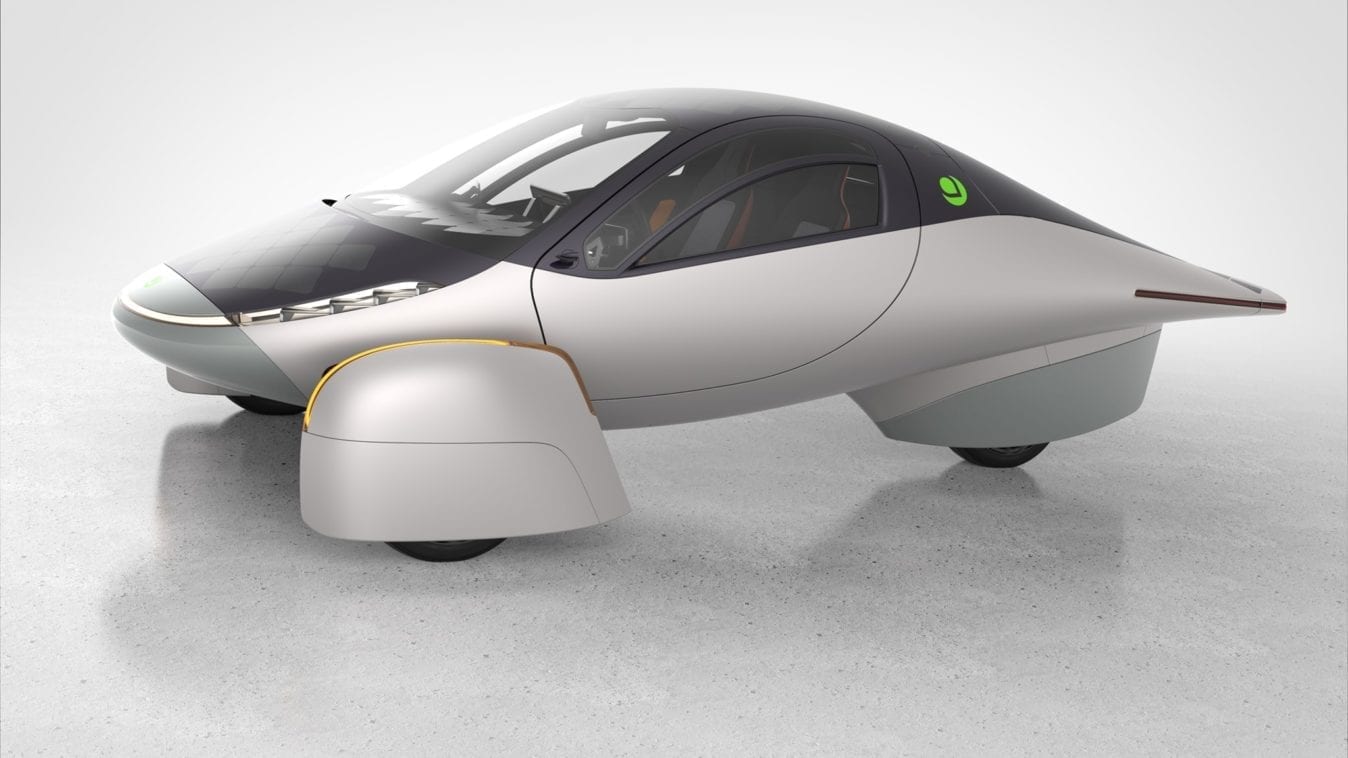
Get $30 off your Aptera Pre-Order
Click this link and you’ll receive a promo code for $30 off an Aptera pre-order. The 2nd Generation Aptera launched Dec. 4, 2020 and is on track to be the first self charging electric vehicle. The two-person, three-wheeler is covered with solar panels which allow self-charging but it also comes with a plug for charging. For every person I refer, I’ll earn a $1,000 credit towards an Aptera. After referring 26 people, I’ll score a free standard edition model. I’m a volunteer Aptera Ambassador, read more about this incredible solution to beautiful design and the ultimate in sustainability! Thanks for your referral, Chuck Lohre, Editor, Green Cincinnati Education Advocacy. #aptera #apteramotors


